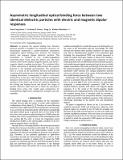Files in this item
Asymmetric longitudinal optical binding force between two identical dielectric particles with electric and magnetic dipolar responses
Item metadata
| dc.contributor.author | Duan, Xiao-Yong | |
| dc.contributor.author | Bruce, Graham D. | |
| dc.contributor.author | Li, Feng | |
| dc.contributor.author | Dholakia, Kishan | |
| dc.date.accessioned | 2022-06-07T12:30:11Z | |
| dc.date.available | 2022-06-07T12:30:11Z | |
| dc.date.issued | 2022-07-12 | |
| dc.identifier | 279848316 | |
| dc.identifier | 2c3e4ddc-f350-4a54-8843-f7f7ae49b224 | |
| dc.identifier | 000830488300003 | |
| dc.identifier | 85135743253 | |
| dc.identifier.citation | Duan , X-Y , Bruce , G D , Li , F & Dholakia , K 2022 , ' Asymmetric longitudinal optical binding force between two identical dielectric particles with electric and magnetic dipolar responses ' , Physical Review A , vol. 106 , no. 1 , 013108 . https://doi.org/10.1103/PhysRevA.106.013108 | en |
| dc.identifier.issn | 2469-9934 | |
| dc.identifier.other | ArXiv: http://arxiv.org/abs/2111.08173v2 | |
| dc.identifier.other | ORCID: /0000-0003-3403-0614/work/117996857 | |
| dc.identifier.uri | https://hdl.handle.net/10023/25499 | |
| dc.description | Funding: This work was supported by Jiaxing Science and Technology Project Grants (No.2021AY10057), KD acknowledges support of the UK Engineering and Physical Sciences Research Council (grant EP/P030017/1). | en |
| dc.description.abstract | In general, the optical binding force between identical particles is thought to be symmetric. However, we demonstrate analytically a counterintuitively asymmetric longitudinal optical binding force between two identical electric and magnetic dipolar dielectric particles. This homodimer is confined in two counterpropagating incoherent plane waves along the dimer's axis. The force consists of the electric dipolar, magnetic dipolar, and electric-magnetic dipolar coupling interactions. The combined effect of these interactions is markedly different than the expected behavior in the Rayleigh approximation. The asymmetric force is a result of the asymmetric forward and backward scattering of the particles due to the dipolar hybridization and coupling interactions. Consequently, it leads to a harmonic driving force on the pair, which decays with the interparticle distance to the first power. We show the rich nonequilibrium dynamics of the dimer and of the two particles impelled by the driving and binding forces and discuss the ranges of particle refractive index and size in which the asymmetric binding force arises. Our results open perspectives for nonequilibrium light-driven multiparticle transport and self-assembly. | |
| dc.format.extent | 10 | |
| dc.format.extent | 1149169 | |
| dc.language.iso | eng | |
| dc.relation.ispartof | Physical Review A | en |
| dc.subject | QC Physics | en |
| dc.subject | TK Electrical engineering. Electronics Nuclear engineering | en |
| dc.subject | DAS | en |
| dc.subject | MCC | en |
| dc.subject.lcc | QC | en |
| dc.subject.lcc | TK | en |
| dc.title | Asymmetric longitudinal optical binding force between two identical dielectric particles with electric and magnetic dipolar responses | en |
| dc.type | Journal article | en |
| dc.contributor.sponsor | EPSRC | en |
| dc.contributor.institution | University of St Andrews. School of Physics and Astronomy | en |
| dc.contributor.institution | University of St Andrews. Centre for Biophotonics | en |
| dc.contributor.institution | University of St Andrews. Sir James Mackenzie Institute for Early Diagnosis | en |
| dc.contributor.institution | University of St Andrews. Biomedical Sciences Research Complex | en |
| dc.identifier.doi | https://doi.org/10.1103/PhysRevA.106.013108 | |
| dc.description.status | Peer reviewed | en |
| dc.identifier.grantnumber | EP/P030017/1 | en |
This item appears in the following Collection(s)
Items in the St Andrews Research Repository are protected by copyright, with all rights reserved, unless otherwise indicated.

